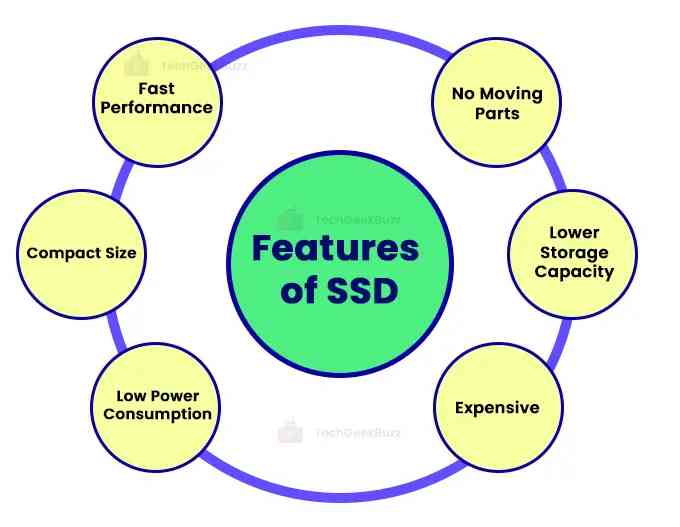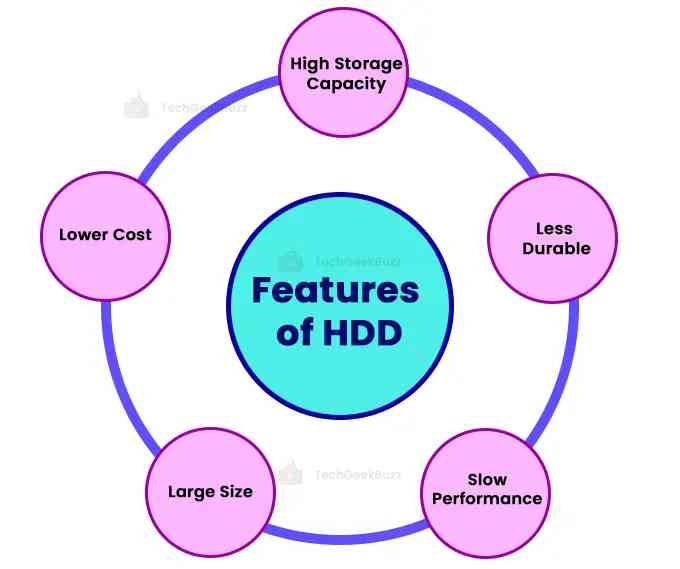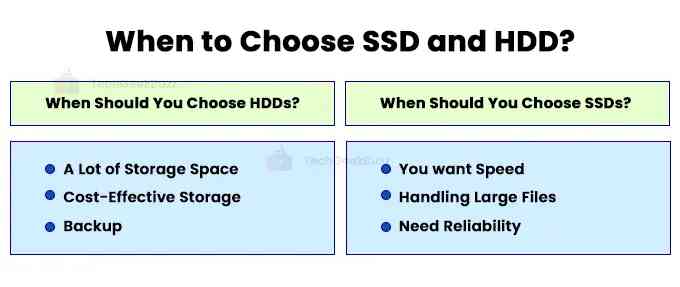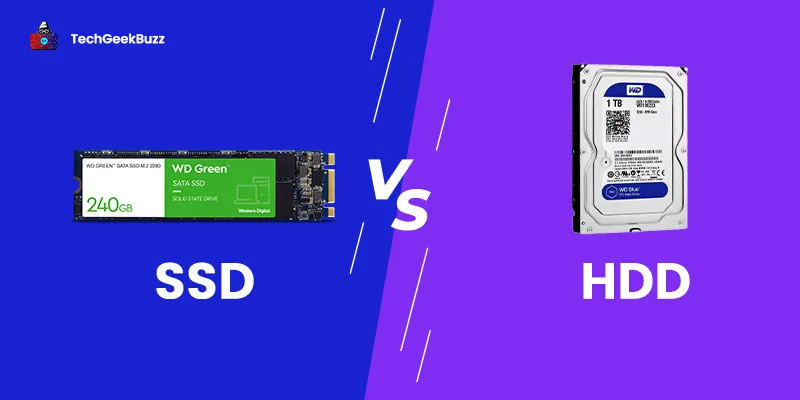Hard disk drives (HDDs) and solid-state drives (SSDs) are the two major non-volatile storage mediums of modern computers. Though both serve the similar purpose of storing data permanently until it is erased, their working and core components are different.
The primary difference between SSD and HDD is how they store and access data. A hard disk drive consists of a metal platter with a magnetic coating and a moving read/write head to store and access data. In contrast, SSD leverages flash-memory chips to store data and contains no moving components.
SSDs are faster, smaller in size, have low latency, offer high input/output rates, and consume less electricity. On the other hand, HDDs are less expensive, available in large storage capacities, and provide easy data recovery in case of any damage.
In today’s technological era, anyone wishing to buy a computer or laptop considers HDD and SSD as major specifications. Hence, understanding the differences between these storage mediums is essential before buying a computer or laptop.
This blog post will walk you through the difference between HDD and SSD and help you determine which storage medium is better to opt for.
SSD vs HDD – A Detailed Comparison of Two Storage Mediums
The following table provides detailed differences between SSD and HDD:
|
Parameters |
HDD |
SSD |
|
Full Form |
Hard Disk Drive |
Solid State Drive |
|
Speed |
Comparatively slower processing |
Faster processing speed |
|
Technology |
Spinning disks and a moving read/write head |
Semiconductor memory (does not have moving components) |
|
Latency |
High latency |
Low latency |
|
Storage Capacity |
Available in large storage capacities, from 250 GB to 18 TB |
Available in limited storage capacities, from 120 GB to 4 TB |
|
Read/Write Time |
Longer |
Shorter |
|
Weight |
Heavier |
Lightweight, as SSDs do not have any mechanical component, like a motor attached to them |
|
Power Consumption |
Spinning disks consumes high amounts of electricity |
Consumes less electricity due to no moveable components |
|
Cost |
Less expensive, as it is a traditional storage medium |
More expensive, as it is the latest storage medium |
|
Size |
Larger |
Smaller |
|
Durability |
Sensitive to physical shocks |
Resistant to physical shocks |
|
Data Transfer |
Sequential |
Random |
|
Noise |
Makes noise due to moving parts |
Executes operations silently |
|
Fragmentation |
Yes |
No |
|
Ideal for |
|
|
What is SSD?

SSD is an acronym for Solid-State Drive. It is a storage device that is non-volatile, and it leverages flash memory and integrated circuit assemblies to store data. The use of integrated circuits significantly reduces the size of SSDs. They come pre-built with a computer, or you can use them externally and plug them into a computer.
In the memory hierarchy, SSD is a secondary storage medium. It does not have physical spinning disks and moving read/write heads as HDDs and floppy disks have. Hence, it does not generate any noise.
Flash memory is a semiconductor memory consisting of individual memory cells to store data bits. Each cell can store a different number of bits, from 1 to 4. As a solid-state drive has no moving parts, it is faster, durable, and resistant to physical shocks. In addition, it has higher input/output rates and low latency.
Here is how SSDs make your computer/laptop faster:
- Booting up an operating system
- Starting a program
- Importing or exporting video files
- Opening a huge, resource-intensive file
- Previewing video files in editing software
Features of SSD

- Fast Performance: SSDs offer higher input/output rates and provide faster data transfer and access speed, offering enhanced performance.
- Compact Size: Using integrated circuits (ICs) contributes to the compact size of solid-state drives.
- Low Power Consumption: SSDs do not have mechanical or moving components. Hence, they consume less energy and power.
- Expensive: Due to the use of cutting-edge technology, solid-state drives are more expensive than HDDs.
- Lower Storage Capacity: SSDs do not offer high storage capacities, unlike HDDs.
- No Moving Parts: Solid-state drives do not make any noise due to the absence of mechanical components.
What is HDD?

HDD is an acronym for Hard Disk Drive. It is also commonly known as a hard drive or fixed drive. Like SSD, HDD is a non-volatile secondary storage medium to store and access digital data.
A hard disk drive encloses multiple rotating platters coated with magnetic material. Each platter has a moving read/write head or magnetic head. It allows you to store and access individual data blocks in random order. Modern HDDs generally are available in the form of a rectangular box.
Due to the presence of mechanical components, a hard drive is slower, offers lower input/output rates, and provides higher latency. Also, it is a more fragile component of a computer. However, its storage capacity makes it cost-effective, and the ability to store data offline makes it a popular choice.
In the early days, HDDs were available as massive, room-filling devices with limited storage capacities of 3.75 MB. However, today, they are extremely compact in size, fit in a desktop computer, and are available in large storage capacities, something up to 18 TB.
Features of HDD

- High Storage Capacity: Many HDD models offer up to 18 TB storage capacity.
- Lower Cost: Regarding storage capacity, the price of HDDs seems very low. They are less expensive than SSDs.
- Large Size: Hard drives comprise mechanical components, spinning disks, and moving read/write heads, contributing to their larger size.
- Slow Performance: The input/output rates and the data transfer and access speed are slower than solid-state drives.
- Less Durable: Usually, mechanical components wear out over time. Hence, HDDs are less durable than SSDs.
Difference Between SSD and HDD – Which is the Better Storage Drive?
We have already discussed the difference between SSD and HDD above. However, we will dive deeper into the differences in this section.
SSD vs HDD – Speed
Speed is the most prominent factor distinguishing SSD from HDD. The speed in a hard disk drive is typically gauged in revolutions per minute (RPM).
The higher the number of revolutions per minute, the greater the speed of a hard disk drive.
HDDs in personal computers and laptop spin at 5400 RPM or 7200 RPM. A drive with 5400 RPM offers the speed equivalent to 100 MB/s, and 7200 RPM offers a speed of 150 MB/s In servers, hard drives spin at 15000 RPM.
The speed is measured in MB/s (Megabytes per second) for solid-state drives. A solid-state drive can process at 700 MB/s, while a hard drive can process at 500 MB/s. This faster speed of SSD results in faster loading of apps, or the device boots up instantly when logged into it.
SSD vs HDD – Lifespan
Earlier, SSDs would have a shorter lifespan due to the technology used in manufacturing them. It was impossible for a solid-state drive to write as many times as the disk in a hard drive. However, in this modern era, the lifespan of SSD is nearly similar to HDD.
As solid-state drives are made of semiconductor chips with several cells, these cells support limited read/write operations. If we write more data to cells, they wear early.
Thanks to Advanced Technology Attachment ( ATA ) command called TRIM, which optimizes read/write cycles dynamically. You can now write data to the SSD 24/7 without worrying about the drive's failure.
As a result, the lifespan of SSD and HDD are now equal.
SSD vs HDD – Reliability/Durability
Solid-state drives have no moving components, so they are not prone to physical shocks or get damaged if your computer drops accidentally. This characteristic of the SSD makes it more reliable even in extreme conditions (high and low temperatures).
On the other hand, the moving components in hard disk drives make them more prone to physical shocks and damage. If your HDD or laptop/computer falls down accidentally, there are high chances of losing all the stored data. The reason is that the moving components may break or collide, which causes great damage to the drive.
Hence, SSDs are more reliable than HDDs.
SSD vs HDD – Security and Data Recovery
Whether a solid-state or hard drive fails, we can recover data. The major difference lies between the process involved and the cost required.
It is possible to recover data on the SSD faster than the HDD. However, you need to spend more money, as SSDs are new technology. They require specialized knowledge and equipment to recover deleted files.
On the other hand, recovering deleted files from the HDD is much more straightforward than in SSDs. A simple data recovery software is enough.
Regardless of any drive you choose for data storage, frequent backups to external storage devices or cloud storage services are essential to avoid data loss.
SSD vs HDD – Capacity
Regarding the storage capacity, there is no difference between both drives. You can get a hard drive or solid-state drive with capacities ranging from as small as 128 GB to as significant as 20 TB.
The difference lies in the price. A solid-state drive with a larger storage capacity is eventually more expensive. Modern SSDs are available in different capacities, from 128 GB to 2 TB. The larger SSD available for an average consumer had a storage capacity of 8 TB.
Furthermore, Samsung and Toshiba, in 2018, introduced SSDs with 30.72 TB capacity using the same 2.5-inch form factor. Nimbus Data introduced and shipped the SDD of 100 TB capacity using the SATA interface. Hence, SSDs have expanded over time, offering more storage.
In contrast, hard disk drives are always available in significant capacities. Today, they are commercially available with storage of upto 20 TB.
SSD vs HDD – Cost
In terms of cost, SSDs are more expensive than HDDs. The reason for this is the use of cutting-edge technology.
The price of SSDs had significantly lower than in the early times. SATA SSDs are less expensive than M2 and PCIe SSDs.
SSD vs HDD – Noise
The mechanical components of a hard drive (spinning disks and moving read/write heads) generate significant noise. Conversely, SSDs make no noise, as there are no moving components.
SSD vs HDD – Power Consumption
Hard disk drives tend to consume more power due to their mechanical components, which constantly move while in use. As SSDs have non-moving components, they consume less power. Hence, modern laptops come with SSDs, which do not drain the battery faster.
Hard Disk Drive or Solid-State Drive – Which One Should You Choose?
Though after knowing all the differences between these drives, it might be daunting to make a suitable choice. We have simplified decision-making for you.

When Should You Choose HDDs?
Here are some use cases where HDDs fit perfectly:
-
A Lot of Storage Space
Hard disk drives offer massive storage space. Hence, you can use it when you want to store heaps of data. Store games and other applications of larger size in hard drives.
-
Cost-Effective Storage
Hard drives are less expensive, offering large storage space. Hence, they are cost-effective. If you get 2TB of a hard drive at $50, you can find the SSD with the same storage capacity but at double the price.
-
Backup
HDDs are ideal for backup purposes, as they offer enormous storage capacity at a lower cost.
When Should You Choose SSDs?
Use a solid-state drive when:
-
You want Speed
If speed and performance are your concern, using a solid-state drive is ideal. It loads applications and games faster, enabling you to use them quickly. Even the slowest SSD loads your files and programs 10 times faster than a faster HDD.
-
Handling Large Files
While working with an SSD, you do not have to worry about the speed and size of your files. You can quickly access and handle large files on your computer or laptop, accelerating your workflow.
-
Need Reliability
SSDs are resistant to physical damage because they do not have moving components. Hence, you do not need much attention to handle SSDs.
Conclusion
This was all about the difference between SSD and HDD. Though both share a similar data storage and retrieval purpose, they differ due to the underlying technology. While HDDs are composed of mechanical components, SSDs use semiconductor chips with flash memory, which are non-mechanical.
The underlying technology of the SSD makes it faster, more reliable, and more energy-efficient, resulting in high input/output rates and low latency.
A hard drive is ideal when you need high storage space at an affordable price and want to store data for a long time. Conversely, choose a solid-state drive if you don’t want to compromise your computer’s speed and performance.
We recommend you make a better choice depending on your requirements.
People are also reading:


![What is an Assembler? [Definition, Working, & Types]](/media/new_post_images/What_is_Assembler.jpg)
![What is I/O? [Types, Examples, & Methods]](/media/new_post_images/What_is_I_O.webp)

Leave a Comment on this Post